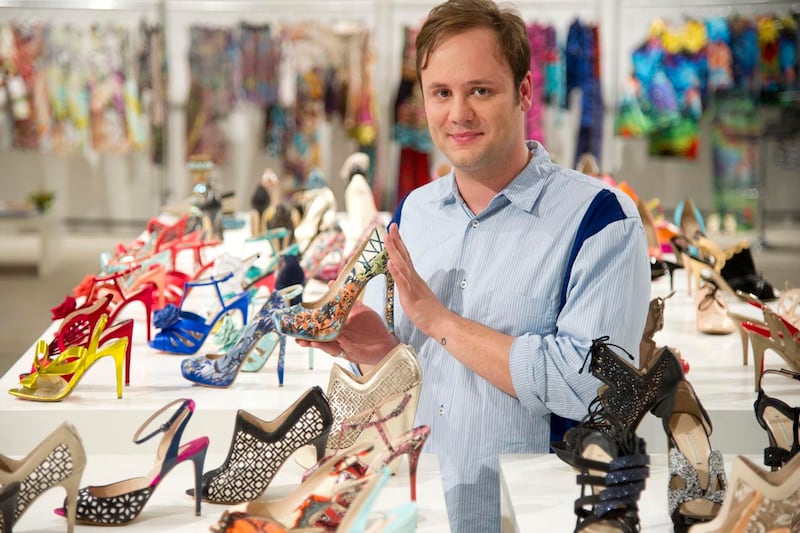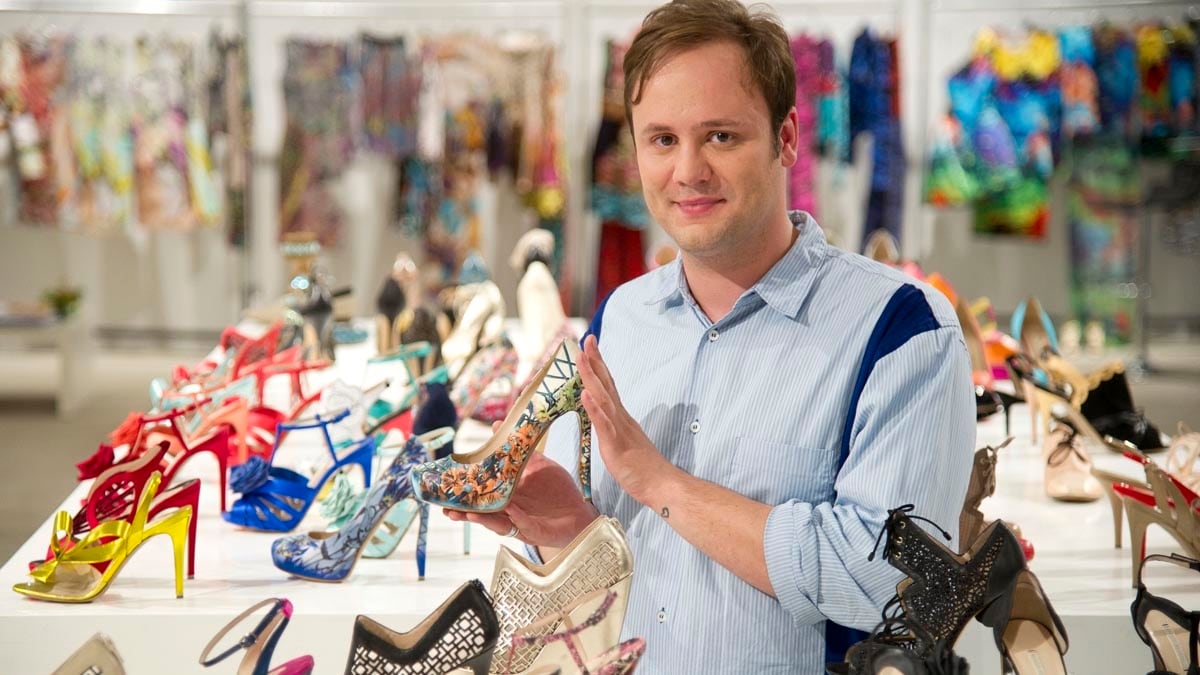
Nicholas Kirkwood is running late. It’s the final morning of London Fashion Week, and he’s coming from Roksanda Ilincic’s fashion show on the other side of town. He has been friends with Ilincic, a popular British-Serbian designer, for years—and has created a few pastel-colored spike heels for her latest collection. But this is what Kirkwood does: he’s a team player, working on eight collaborations a year with other young designers in addition to his own.
His Mount Street store sits on a busy corner of London’s Mayfair district, in a building with a dramatic marble and gold façade. Inside, it feels as if you’re floating in some sort of space station: there are futuristic, white-blocked shelves and a French salesman who seems to glide across the shiny black floor. Not to mention Kirkwood’s shoes, which have developed a cult following across the world after only a few years. Stacked high on a maze of shelves, his designs look like a laboratory of experiments. There’s a petite woman trying on the style that Sarah Jessica Parker made famous in 2010. “These would work well for to dinner in Dubai,” she says to the mirror. Elsewhere, there are preppy neon slippers, floral kitten heels, and S&M-y patent leather wedges.
For the past several years, Kirkwood has become a star of London’s fashion lineup. He’s earned international popularity and a diehard following, and has picked up several design awards. His shoes are stocked in 130 stores worldwide, including major U.S. retailers such as Barneys and Saks Fifth Avenue. He also has revived Pollini, the Italian accessories brand, as its creative director, and designed capsule collections for Swarovski. This week he opens his first store in the United States, in New York’s Meatpacking District, and has his sights set on Los Angeles, too, where he has already toured retail spaces. Altogether this year, he will open an e-commerce site, produce six collections for his eponymous label, and shoes for collaborations with designers including Erdem, Peter Pilotto, and Prabal Gurung. In addition, he will produce a shoe in honor of Queen Elizabeth’s jubilee for Selfridges in June.
When he finally arrives at the store, Kirkwood is winded, clutching an empty bottle of iced tea and brimming with apologies. I follow him through a floor-to-ceiling mirror, which is a trap door that leads down a narrow staircase to his all-white subterranean studio, filled with inspiration boards, fabric samples, and piles of sketches. Two interns glance up from large-screen Macs. They’re finishing up work on the Fall/Winter 2012 collection for Kirkwood’s own label, which will be presented during Paris Fashion Week in early March. The inspiration this season is Paris in the 1920s—Midnight in Paris meets Elsa Schiaparelli. The collection features slip-ons adorned with Cubist faces, thigh-high velvet boots, and even heels with real hair ponytails coming out the back. “It took me about three years before I started to do a basic pump,” he says. “And that’s because I thought, ‘Why would you come to me for a basic pump when you could go to somebody else?’”
Soon after graduating from the prestigious Central Saint Martins school in 1999, Kirkwood met the legendary British milliner Philip Treacy during a ski trip to Klosters with his brothers. “They were really rowdy,” says Treacy, remembering the trip. Before long Kirkwood began as a salesman in Treacy’s London shop, where Treacy would often find Kirkwood asleep at work. “You’re here to sell hats!” the designer would shout at his intern. But Treacy remembers that Kirkwood had a way with clients. “I loved the fact that he didn’t suck up to customers,” he tells The Daily Beast. “He was absolutely charming and sweet and helpful, which is how I think retailing should be. He was not aggressive and not attacking them into buying the product.”
Kirkwood says he learned from Treacy “the idea of not trying to do something for the sake of sales. If you’re going to say something, say it with conviction. Don’t wash it down, because it may appeal more to the masses.” He pauses and looks at the design boards piled around his studio. “I’d rather mean more to less people than not very much to a lot of people.” Indeed, Kirkwood's designs are expensive, with most retailing for over $1,000.
Now, he says, he feels it is necessary to constantly be original and new, and to invent new styles every season rather than to regurgitate the same shoes in new patterns. “I’ve tried to build the brand on an aesthetic and recognize all sorts of shapes which haven’t been referenced in vintage shoes and just invent them,” he says. “I don’t work with referencing material. I think that’s a good way—it forces your mind to come up with another solution.”
Kirkwood is largely uninterested in the idea of heels that will blend in with a business suit. The Universe of Keith Haring, the documentary about the pop artist, drove Kirkwood to create an entire capsule collection around Haring last year. “It just seemed like it was a huge opportunity there to do something that was really fun,” he says. He produced a creative and subversive 12-piece collection inspired by the pop artist, including Swarovski crystal-encrusted roller skates, a heel held up by a Haring figure—even a shoe depicting a hand job.
Even though his shoes seem to be some strange combination of Santiago Calatrava and Space Odyssey, there’s an element of function to Kirkwood’s designs as well. The designer says he regularly tests new styles for comfort on friends and interns in his studio. “If it’s four yeses and a no, then it’s pretty much a yes,” he says. “If it’s half and half, then we have to keep trying.” According to Cecilia Dean, co-founder and editor of Visionaire magazine and an early supporter of the designer, Kirkwood has “a real talent to make show-stoppers that women can actually wear for eight hours straight.”
Because of Kirkwood’s penchant for the avant-garde (and distaste for plain pumps), the Duchess of Cambridge would not appear to be the ideal client. “It’d be great if she did wear the shoes,” he says of Kate Middleton. “She just wears too much High Street stuff. I know she’s trying to be democratic, but I don’t know how many pairs of LK Bennett you can wear. She does occasionally come out and is wearing McQueen or something like that. It’s like, ‘Do that more! You’re meant to be a princess-y type of person, so act like one!’” (The one person Kirkwood says he would love to dress is, unsurprisingly, Tilda Swinton.)
Kirkwood’s expansion to the United States feels, in some way, like a dare for what he can dream up next. “The challenge and ultimate test,” says Dean, “will be whether he can maintain that level of creativity and grow the business at the same time.”





